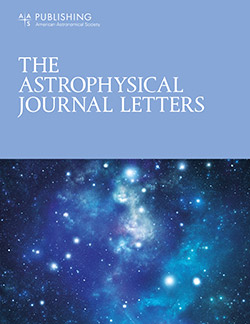JWST Constraints on the UV Luminosity Density at Cosmic Dawn: Implications for 21 cm Cosmology
IF 11.7
1区 物理与天体物理
Q1 ASTRONOMY & ASTROPHYSICS
引用次数: 1
Abstract
Abstract An unprecedented array of new observational capabilities are starting to yield key constraints on models of the epoch of first light in the Universe. In this Letter we discuss the implications of the UV radiation background at cosmic dawn inferred by recent JWST observations for radio experiments aimed at detecting the redshifted 21 cm hyperfine transition of diffuse neutral hydrogen. Under the basic assumption that the 21 cm signal is activated by the Ly α photon field produced by metal-poor stellar systems, we show that a detection at the low frequencies of the EDGES and SARAS3 experiments may be expected from a simple extrapolation of the declining UV luminosity density inferred at z ≲ 14 from JWST early galaxy data. Accounting for an early radiation excess above the cosmic microwave background suggests a shallower or flat evolution to simultaneously reproduce low- and high- z current UV luminosity density constraints, which cannot be entirely ruled out, given the large uncertainties from cosmic variance and the faint-end slope of the galaxy luminosity function at cosmic dawn. Our findings raise the intriguing possibility that a high star formation efficiency at early times may trigger the onset of intense Ly α emission at redshift z ≲ 20 and produce a cosmic 21 cm absorption signal 200 Myr after the Big Bang.JWST对宇宙黎明紫外线亮度密度的约束:对21厘米宇宙学的启示
一系列前所未有的新观测能力开始对宇宙中第一束光的时代模型产生关键约束。在这封信中,我们讨论了由最近的JWST观测推断的宇宙黎明紫外线辐射背景的含义,这些观测旨在探测漫射中性氢的21厘米红移超精细跃迁。在假定21 cm信号是由贫金属恒星系统产生的Ly α光子场激活的基本假设下,我们表明,从JWST早期星系数据中推断出的z > 14处紫外线亮度密度下降的简单外推,可以预期EDGES和SARAS3实验的低频探测。考虑到宇宙微波背景之上的早期辐射过剩,表明一个较浅或平坦的演化,以同时再现低z和高z电流紫外光度密度约束,鉴于宇宙方差的大不确定性和宇宙黎明时星系光度函数的微弱端斜率,这不能完全排除。我们的发现提出了一种有趣的可能性,即早期的高恒星形成效率可能会触发在红移z > 20处强烈的Ly α发射,并在大爆炸后产生200 Myr的宇宙21 cm吸收信号。
本文章由计算机程序翻译,如有差异,请以英文原文为准。
求助全文
约1分钟内获得全文
求助全文
来源期刊

Astrophysical Journal Letters
ASTRONOMY & ASTROPHYSICS-
CiteScore
14.10
自引率
6.30%
发文量
513
审稿时长
2-3 weeks
期刊介绍:
The Astrophysical Journal Letters (ApJL) is widely regarded as the foremost journal for swiftly disseminating groundbreaking astronomical research. It focuses on concise reports that highlight pivotal advancements in the field of astrophysics. By prioritizing timeliness and the generation of immediate interest among researchers, ApJL showcases articles featuring novel discoveries and critical findings that have a profound effect on the scientific community. Moreover, ApJL ensures that published articles are comprehensive in their scope, presenting context that can be readily comprehensible to scientists who may not possess expertise in the specific disciplines covered.
 求助内容:
求助内容: 应助结果提醒方式:
应助结果提醒方式:


